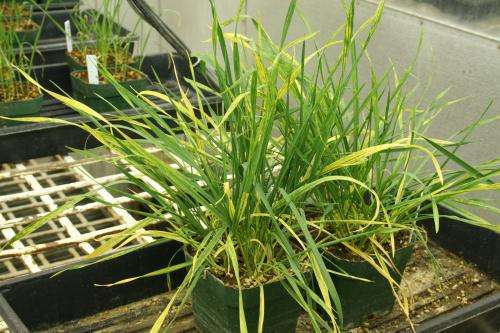Better genetic markers developed for wheat streak mosaic virus resistance

(Phys.org) —Texas A&M AgriLife Research is developing genetic diagnostic markers to identify wheat streak mosaic virus resistance, providing wheat breeders a new tool in breeding wheat varieties resistant to one of the region's most prevalent diseases.
The study includes work by AgriLife Research scientists in Amarillo, including Dr. Shuyu Liu, small grains geneticist; Silvano Ocheya, doctoral graduate student in College Station; Dr. Jackie Rudd, wheat breeder; and Dr. Qingwu Xue, crop stress physiologist.
They were joined by Dr. Guorong Zhang, wheat breeder at Kansas State University Agriculture Research Center at Hays, Kan.; and Dr. Guihua Bai, U.S. Department of Agriculture-Agricultural Research Service Central Small Grain Genotyping Center at Manhattan, Kan.
Wheat streak mosaic virus, which is transmitted by wheat curl mite, is one of the major limiting factors for wheat production in the Southern High Plains, Liu said. The yield loss can be up to 50 percent due to wheat streak mosaic virus in any given epidemic year.
There are several resistance genes to wheat streak mosaic available, but only one gene, labeled Wsm2, is from a wheat line, he said. The other two are from wheat relative species. Wsm2 has been bred in two wheat cultivars, RonL and Snowmass. This resistance gene is now being used by breeders in Kansas, Colorado and Texas to combine with other traits.
Ocheya, funded by Monsanto Beachell Borlaug Scholarship, is using a wheat population derived from CO960293-2 and TAM 111 to map the drought tolerance genes in TAM 111 and identify tight linked single nucleotide polymorphic or SNP markers, for drought tolerance genes and Wsm2. SNPs are variations within the DNA.
Zhang helped to evaluate the wheat streak mosaic virus infection on the population at growth chamber conditions under 64.5 degrees using virus strain Sidney 81.
The international wheat community, including the U.S., has developed a chip with 90,000 SNP markers, which can be used to screen wheat lines. Ocheya mapped about 5,000 SNP onto the whole wheat genome. Several tightly linked SNP markers to the Wsm2 gene were found, he said.
These markers were converted into high throughput SNP markers by Bai and his associates. These converted breeder-friendly SNP markers have been used to screen F2 breeding populations inoculated with the virus strain Sidney 81. This confirmed they are much better than any other previously used markers, Zhang said.
"These newly developed diagnostic SNP markers are being applied to marker-assisted selection for Wsm2 in several breeding programs in the High Plains, including Texas," Liu said.
Provided by Texas A&M University




















